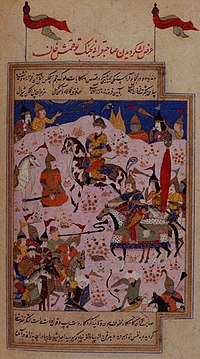Tokhtamysh-Timur war
| Tokhtamysh–Timur war | |||||||
|---|---|---|---|---|---|---|---|
 Timur and his troops persuading him to launch a war against Tokhtamysh. |
|||||||
|
|||||||
| Belligerents | |||||||
|
|
Timurid Empire | ||||||
| Commanders and leaders | |||||||
|
|
Timur | ||||||
The Tokhtamysh–Timur war was fought in the 1380s and early 1390s between Tokhtamysh, khan of the Golden Horde and the warlord and conqueror Timur, founder of the Timurid Empire, in the areas of the Caucasus mountains, Turkistan and Eastern Europe. The battle between the two Mongol rulers played a key role in the decline of the Mongol power over early Russian principalities.
In the late 1370s and early 1380s, Timur helped Tokhtamysh to assume supreme power in the White Horde against Tokhtamysh's uncle Urus Khan. After this he united the White and Blue Hordes, forming the Golden Horde, and launched a massive military punitive campaign against the Russian principalities between 1381 and 1382, restoring the Turko(tartar)Mongol power in Russia after the defeat in the Battle of Kulikovo. The Golden Horde, after a period of anarchy between the early 1360s and late 1370s, passed for a briefly reestablishing as a dominant regional power, defeating Lithuania in Poltava around 1383. But Tokhtamysh had territorial ambitions in Persia and Central Asia, and on account of this he turned against his old ally, Timur.
After the death of Abu Sa'id in 1335, the last ruler of the Ilkhanid Dynasty, a power vacuum emerged in Persia. Persia's vulnerability led to military incursions from Persia's neighbours. In 1383 Timur started his military conquest of that country. In 1385 he captured Herat, Khorasan and all of eastern Persia. In the same year Tokhtamysh raided Azerbaijan and northwestern Iran. The city of Tabriz was plundered and Tokhtamysh could retire with a rich booty.
...
Wikipedia
